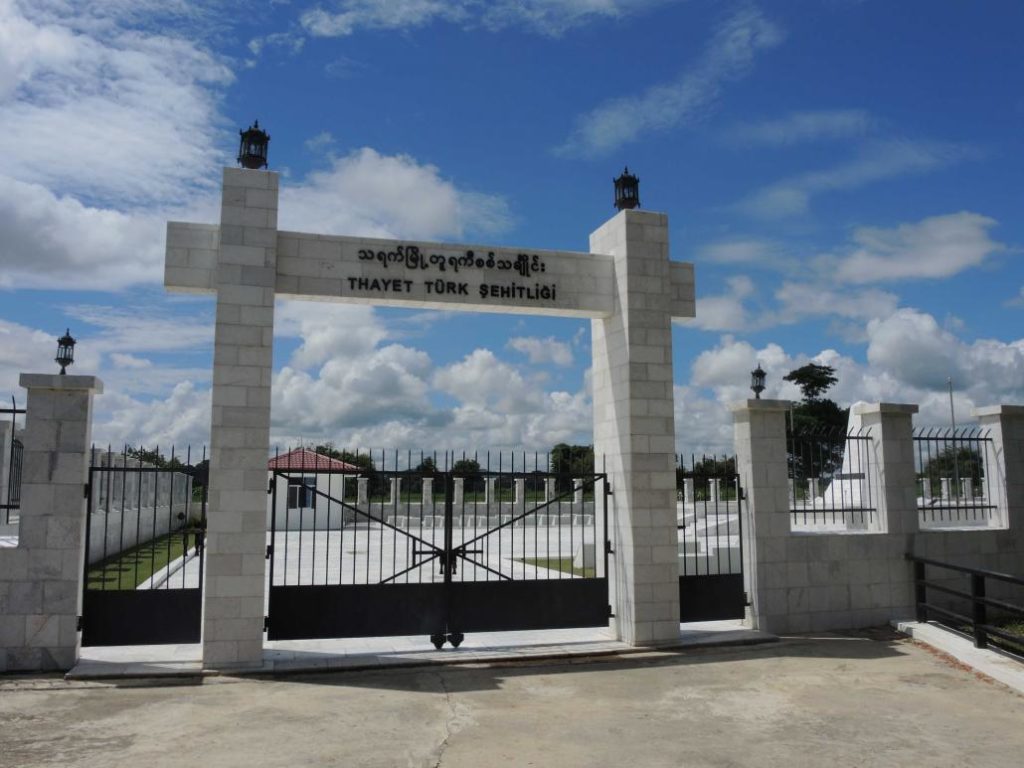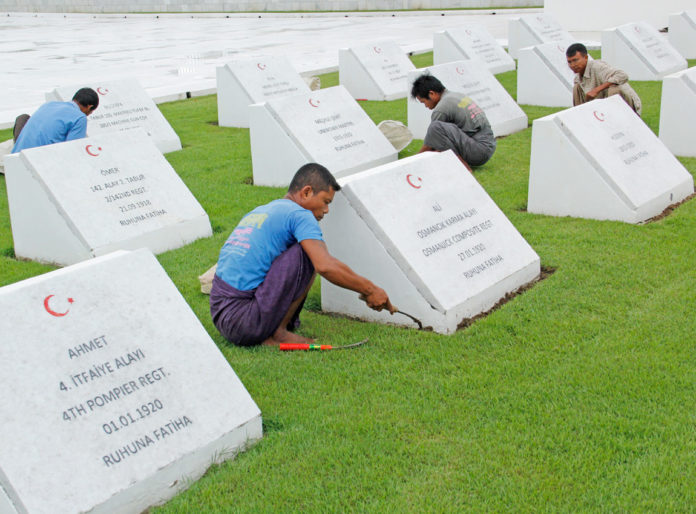The First World War was a global conflict with millions of soldiers fighting in theatres all over the globe. All belligerents captured hundreds of thousands of prisoners of war (POWs). British, Prussian, Czarist, Ottoman and Austro-Hungarian empires mobilized native citizens as well imperial subjects for war.
The Ottoman Empire was influenced by Prussian military system as well as success of Mehmet Ali Pasha’s modernized Egyptian army against its own army in Syria in 1831-33. On the eve of the Great War, the Ottoman Empire was a multi-religious and multi-ethnic society, however, a new wave of nationalism with emphasis on Turkish ethnicity weakened old bonds. On the other hand, non-Muslim Balkan and Greek subjects of Ottoman Empire had achieved their independence by successfully breaking away and Armenians were also looking at nationalism as a cherished goal. The Empire tried to pivot towards its Muslim roots to confront Russian threat across the border and contain Armenian nationalism inside the borders. On the eve of the Great War, the Ottoman army was mainly recruited from the Muslim Anatolian heartland. Turks formed the bulk of the army and were seen as the back bone and most reliable soldiers although many Kurds, Laz and Circassians also served. Non-Turkish Muslim subjects especially Arabs stayed away from military service. Non-Muslim subjects never opted for a military career. Military service was obligatory for every citizen, but non-Muslims could opt out by paying a fee and most non-Muslims took this route.
German Military Mission under the leadership of Otto Liman Sanders embarked on reformation of Ottoman military just a few months before the outbreak of the war. The Empire was already trying to recover from the devastating effects of the Balkan war (1912-13) with loss of large swaths of territories, 340’000 casualties and influx of close to half a million Muslim refugees from the lost territories. When the Ottoman Empire entered the Great war it faced the dilemma where it was distrustful of its non-Muslim citizens on the one hand but needed the special skills of an educated and technical proficient non-Muslim minority. Three main non-Muslim groups were Armenians, Greeks and Jews. In Medical Corps many non-Muslim doctors served as commissioned officers. Army was divided into com-bat and non-combat units. Non-Muslims (Greek, Armenian and Assyrian subjects of the Empire) were predominantly recruited in labor battalions. Almost half a million men deserted during the war. Majority were Muslim soldiers. but many non-Muslim soldiers also deserted.
Ottoman Empire mobilized around 2.6 million soldiers for the war. Around 250’000 were captured by allied forces. The largest numbers were captured by the British while the Russians, French, Romanians and Italians also captured large numbers.
Most Ottoman soldiers captured by the British in Middle Eastern theatres were kept at POW camps in Mesopotamia, Egypt, Malta and Cyprus while some were transported to India and Burma. Burma was part of India until 1937 when it was separated from India. In India, these POW camps were at Sumerpur in Rajputana and Bellary in Bombay presidency (now state of Karnataka) and in Burma at Meiktila and Thayetmyo. There was a quarantine camp in Rangoon and a convalescent camp at Schwebo.
POWs destined for India and Burma were first brought to Basra which had two camps, one isolation camp to quarantine prisoners with disease and an observation camp Usually prisoners stayed for 2-4 weeks at observation camp before transportation to India and Burma. Prisoners were transported by boats to Karachi and Bombay and were then transported by rail to two camps in India, At Bellary. most POWs were ethnic Turks while majority of POWs at Sumerpur were non-Turkish (Arabs. Christians and Jews). The Sumerpur camp contained 3’366 POWs. Majority of prisoners were non-Turkish and consisting of Arabs and Christians. Camp’s medical director was Captain M. D. Wadia, he was Medical Officer of 97th Deccan Infantry and later also served with 2nd Queen Victoria’s Own Rajput Light Infantry. He was fluent in Persian and Arabic. In addition, two Armenians fluent in English, French and Arabic acted as interpreters. The Muslims prayed in a small mosque of the camp. A French monk came regularly to camp for mass for Catholic Christians of the camp. Armenian Bishop of Cairo Thorgom Koushagian visited the camp during Christmas of 1916. POW camp at Bellary was in the cantonment. In the spring of 1917. it contained only 137 prisoners; almost all officers. Later, more prisoners were brought here, it had a large hospital for British troops. Turkish officers were product of military reforms and secular in out- look. Many regularly consumed alcohol that was forbidden for Muslims. It needed doctor’s order and an officer could buy three bottles of liquor per month. Whisky and soda were popular among officers. Some POWs who died here were buried outside the camp. Most of the graves disappeared during expansion of the military airport. In 1997, Turkish government erected a memorial at the camp site and restored two remaining graves.

Those destined for Burma were transported to Calcutta by rail. POWs stayed at a depot camp at Calcutta for a few days and were then transported by steamers to Rangoon. They were inspected there and sick prisoners were sent to a special hospital. Others were transported by towed steamers on Irrawaddy river to the camp in Thayetmyo. This town was a cantonment and named for mango trees, it contained 3’591 prisoners of which the majority were Turks but there were some Armenians, Syrian Christians and Jews. Muslim, Armenian and Jewish religious communities of Rangoon sent gifts to their co-religionist prisoners. Officers had their own club on the river bank. Several Turkish doctors under the command of Colonel Bahidji Bey assisted two British doctors of the hospital for medical care of prisoners. The British camp commandant recommended to Turkish officers that a mosque should be built however, Subhi Bey who had significant influence among prisoners opposed the suggestion on religious grounds. He stated that when POWs left the mosque would be abandoned and that was not permitted in religious texts.
Meiktila was used as a summer station for British government of the province. A POW camp was established in late 1917 near the lake housing around 10’000 Ottoman POWs. Schwebo was a British military cantonment with a military hospital A convalescent camp for prisoners was established here and a section of hospital was reserved for POWs.
Trauma of imprisonment creates a sense of despondency and most officers remained detached from their men. Religious. ethnic and political divisions created a sense of unease among officers, most prisoners spent whole day sitting idly and playing cards or black gammon. Some Ottoman prisoners were used as laborers on tobacco plantations, digging for a dam and on Shan state railways.
Many Ottoman soldiers who died in captivity were buried in cemeteries at these camps. Around a thousand prisoners died at two camps in Burma, majority were buried at Meiktila camp cemetery and about 200 at Thaetmyo cemetery. In 2012 relations between Myanmar and Turkey improved and the two governments agreed to restore the cemeteries. Thayetmyo cemetery was restored with Turkish funding and work was completed in 2016.
Recently, Burma has seen large scale violence against Muslims. Some bigoted Buddhist monks as well as government forces were involved in large scale violence against Muslims. There is deep anti-Muslim sentiment in the country and Muslims of Rakhine state are viewed as foreigners, In 2013, a rumor spread in the region that old and dilapidated cemetery where Ottoman prisoners were buried at Meiktila would be restored and a mosque will be built there. Turkish government had agreed to restore the cemetery however there was no plan for building a mosque. This rumor resulted in anti-Muslim violence and the plan to restore the cemetery was shelved. That cemetery is in a dilapidated state. Wall and gravestones were plundered in the Second World War and seventy years of neglect erased most marks of the past. Over the years, local Muslims retrieved around 200 gravestones and moved them to the courtyard of a local mosque.
In 2013, the Turkish government also planned to restore POW cemetery at Sumerpur that had about 149 graves. This area is heartland of proud Rajputs who fought on British side in First and Second World Wars. Some locals protested the restoration project arguing that there is no memorial of Rajputs who fought all over the globe while a memorial was being planned for foreign soldiers. Rajputs are chivalrous people and should understand better anyone about respect of sods when they depart from this Mustafa Kamal Ataturk set the test example and his words the memorial of British, Australian and New Zealand soldiers who de at Gallipoli against Turks are a shooing example of chivalry.

‘Those heroes that shed their blood and lost their lives are now lying in the soil of a friendly county. Therefore, rest in peace. There is no difference between Johnnies and the Mehmets to us where they lie side by side here in the country of ours You, the mothers who sent their sons from faraway countries, wipe away your tears; your sons are now lying in our bosom and are in peace. After having lost their lives on this land they have become our sons as well’.
Notes
Red Cross: International Committee. Geneve. Reports on British Prison-camps in India and Burma (London: T. Fisher Unwin Ltd.), 1917
Mehmet Besikei. Mobilizing military labor in the age of total war: Ottoman conscription before and during the Great War in Erik-Jan Zurcher (Editor): Fighting for a Living: A Comparative Study of Military Labour 1500-2000 (Amsterdam University Press, 2013)
Yucel Yanikdag. Review: Marginal Men: Ottoman Prisoners of war in the Great war, The Turkish Studies Association Joumal. Vol. 26, No. 2 (Fall 2002), pp. 3946
Frontier, February 20. 2018
Spectrum. December 09, 2018
The Hindu, October 10, 2000
Hindustan Times, July 11, 2013
Captivity Diaries. This link is best documentary about Ottoman prisoners of war. Commentators are leading researchers on this subject It is in Turkish but has English subtitles. https://www.youtube.com/watch?v=MUpejsqFh4A.




